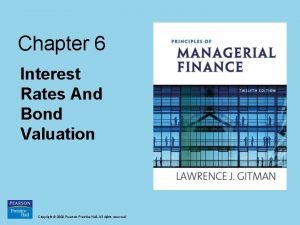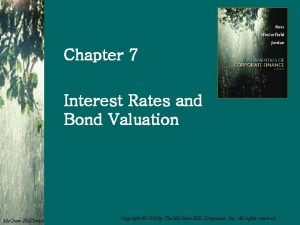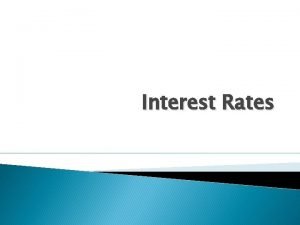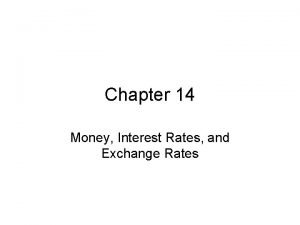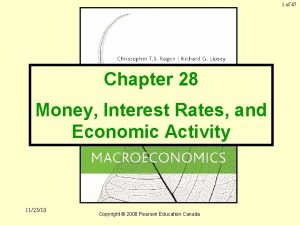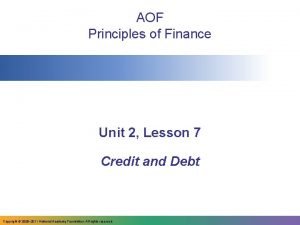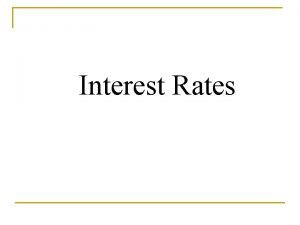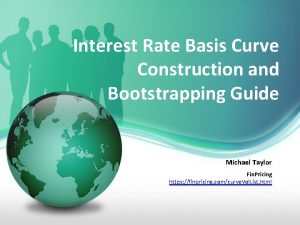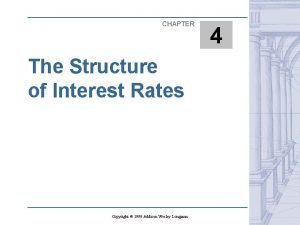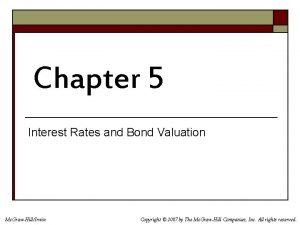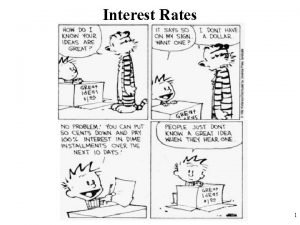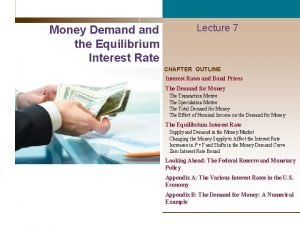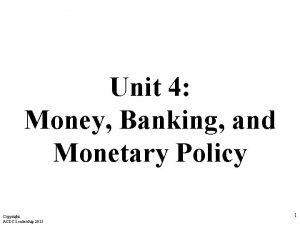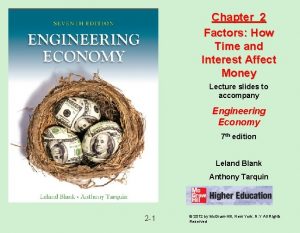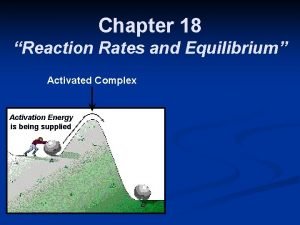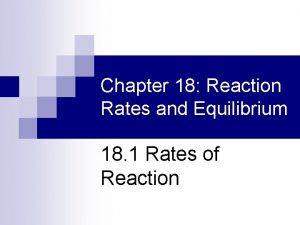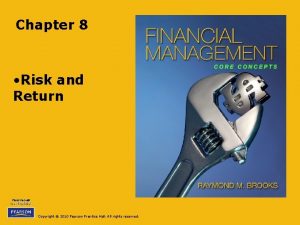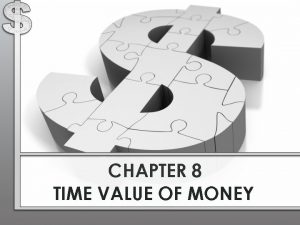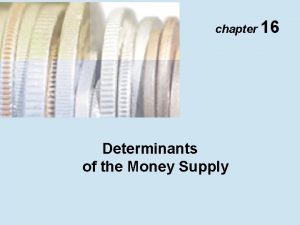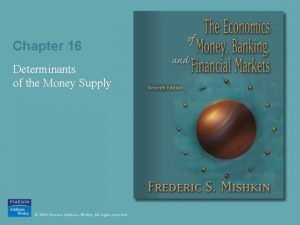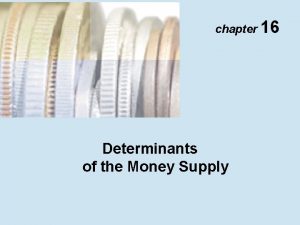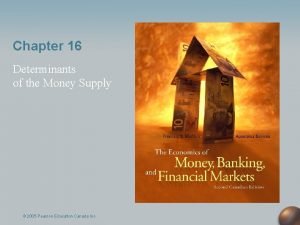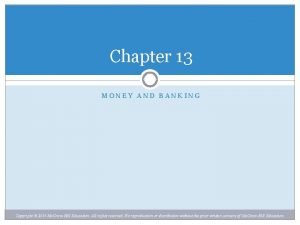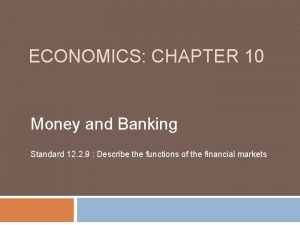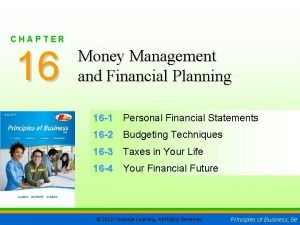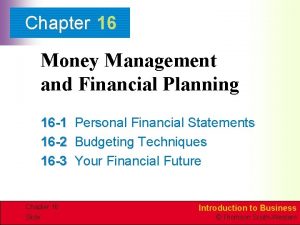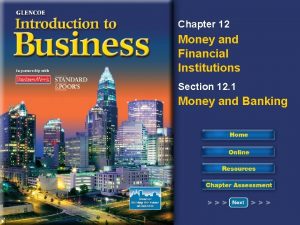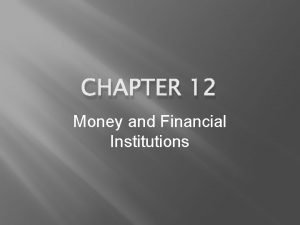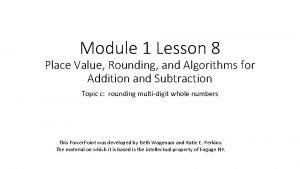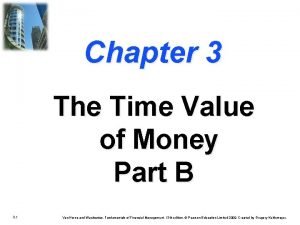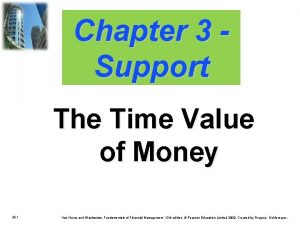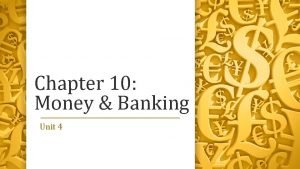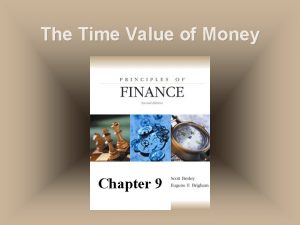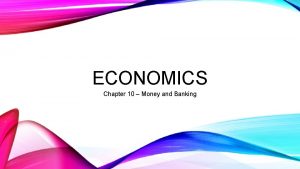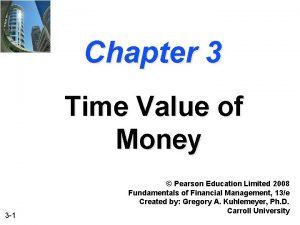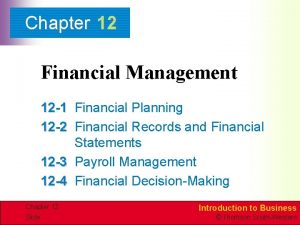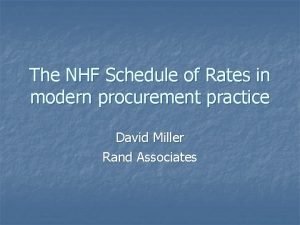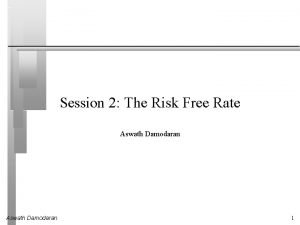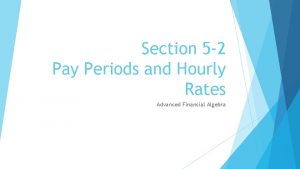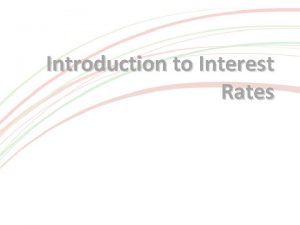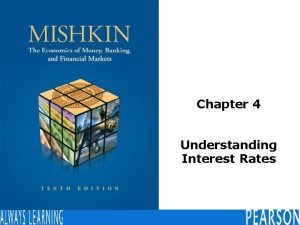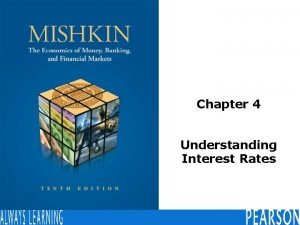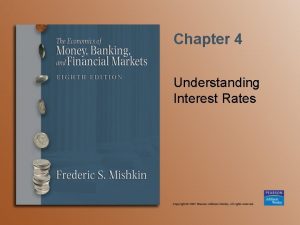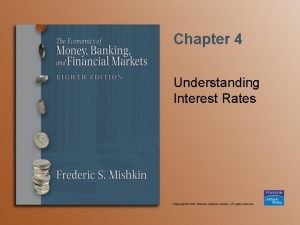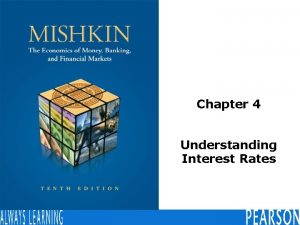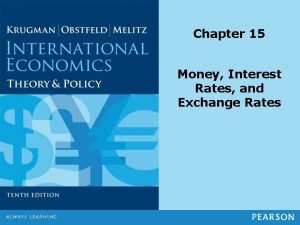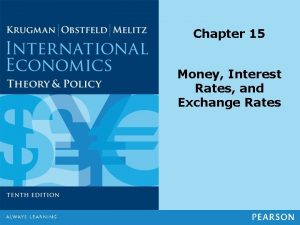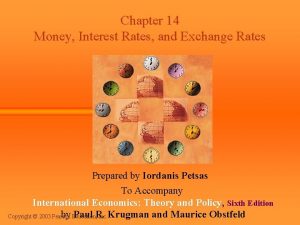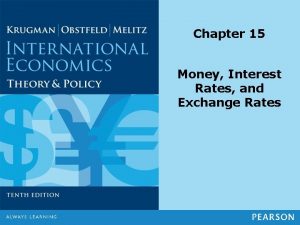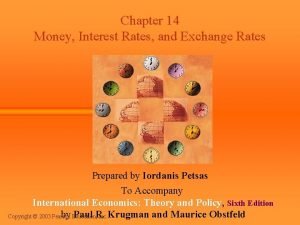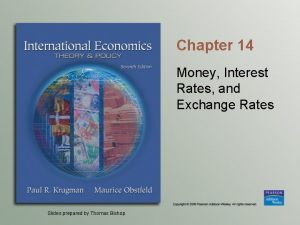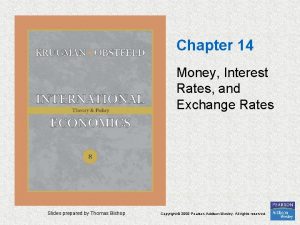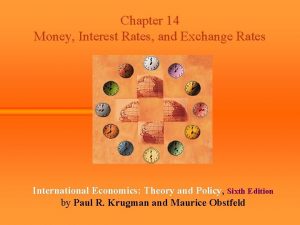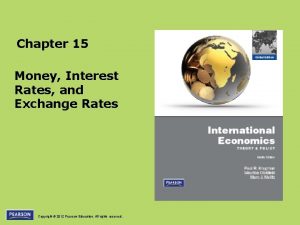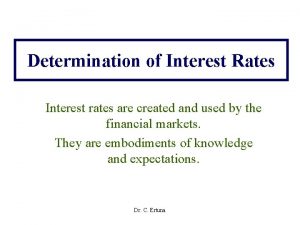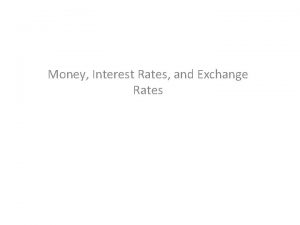1 of 47 Chapter 28 Money Interest Rates































































- Slides: 63

1 of 47 Chapter 28 Money, Interest Rates, and Economic Activity 11/23/10 Copyright © 2008 Pearson Education Canada

2 of 47 In this chapter you will learn 1. why the price of a bond is inversely related to the market interest rate. 2. how the demand for money is related to the interest rate, the price level, and real GDP. 3. how monetary equilibrium determines the interest rate in the short run. 11/23/10 Copyright © 2008 Pearson Education Canada

3 of 47 In this chapter you will learn 4. about the transmission mechanism of monetary policy. 5. the difference between the short-run and long-run effects of monetary policy. 6. when monetary policy is most effective in influencing real GDP in the short run. 11/23/10 Copyright © 2008 Pearson Education Canada

4 of 47 28. 1 UNDERSTANDING BONDS For simplicity, we assume that people have two types of financial assets: - money (earns no interest) - bonds (earn interest) For readers interested in learning more about the stock market, the market in which equities are traded, look for “A Beginner’s Guide to the Stock Market” in the Additional Topics section of this book’s My. Econ. Lab. www. myeconlab. com 11/23/10 Copyright © 2008 Pearson Education Canada

5 of 47 Present Value and the Interest Rate Present value: - the value now of one or more payments or receipts made in the future Consider an asset that pays $X in one year’s time. If the interest rate is i% per year, the PV of the asset is PV = $X/(1+i) Notice that, ceteris paribus, the PV is negatively related to the interest rate. 11/23/10 Copyright © 2008 Pearson Education Canada

6 of 47 Present Value and the Interest Rate Examples Consider an asset that pays $100 in one year’s time. If the interest rate is 5% per year, the PV of the asset is PV = $100/(1. 05) = $95. 24 If the interest rate is 2% per year, the PV of the asset is PV = $100/(1. 02) = $98. 04 If the interest rate is 10% per year, the PV of the asset is PV = $100/(1. 10) = $90. 91 The PV is negatively related to the interest rate. 11/23/10 MFC 2007, MFC 2007 MFC 2007 Copyright © 2008 Pearson Education Canada

7 of 47 Present Value and the Interest Rate The PV is the sum of money that you would need to invest today at interest rate i in order to have $X in n years time PV = $100/(1. 05) = $95. 24 or $95. 24(1. 05) = $100 If the interest rate is 2% per year, the PV of the asset is PV = $100/(1. 02) = $98. 04 or $98. 04(1. 02) = $100 If the interest rate is 10% per year, the PV of the asset is PV = $100/(1. 10) = $90. 91 11/23/10 or $90. 91(1. 10) = $100 MFC 2007, MFC 2007 MFC 2007 Copyright © 2008 Pearson Education Canada

8 of 47 Present Value and Time Period Examples Consider an asset that pays $100 in one year’s time. If the interest rate is 5% per year, the PV of the asset is PV = $100/(1. 05) = $95. 24 If the payment is in two year’s time PV = $100/(1. 05)2 = $90. 70 If the payment is in ten year’s time PV = $100/(1. 05)10 = $61. 39 Notice that, ceteris paribus, the PV is negatively related to the length of time to payment of the money. 11/23/10 MFC 2007, MFC 2007 MFC 2007 Copyright © 2008 Pearson Education Canada

9 of 47 Present Value and the Time Period The PV is the sum of money that you would need to invest today at interest rate i in order to have $X in n years time Consider an asset that pays $100 in one year’s time. If the interest rate is 5% per year, the PV of the asset is PV = $100/(1. 05) = $95. 24 or $95. 24(1. 05) = $100 If the payment is in two year’s time PV = $100/(1. 05)2 = $90. 70 or $90. 70(1. 05) = $100 If the payment is in ten year’s time PV = $100/(1. 05)10 = $61. 39 11/23/10 or $61. 39(1. 05)10 = $100 MFC 2007, MFC 2007 MFC 2007 Copyright © 2008 Pearson Education Canada

10 of 47 A Sequence of Future Payments OPTIONAL Consider this, Derek Jeter is 30 years of age. He quits the Yankees to play for Boston. You read in the newspaper that he got a three year contract ‘worth’ $73 million. Well, actually you read on and find that the contract is as follows: - $1 million per year for each of the next three years plus a $70 million retirement payment at age 55. If the current interest rate is 7% what is this contract worth today? PV = $1, 000/(1. 07) + $1, 000/(1. 07)2 + $1, 000/(1. 07)3 + $70, 000/(1. 07)25 = $934, 579 + $873, 439 + $816, 298 + $12, 897, 442 = $15, 521, 758 contract 11/23/10 If the Red Sox deposit $15, 521, 758 in the bank today, then they can pay for Jeter MFC 2007, MFC 2007 MFC 2007 Copyright © 2008 Pearson Education Canada

11 of 47 A Sequence of Future Payments OPTIONAL You cannot play lotteries if you do not know about present values. A million dollars a year for life! What’s that worth? Consider a million dollars a year for 20 years! Is this a $20 million dollar lottery prize? Well, actually not - If the current interest rate is 8% what is a million dollars a year for twenty years worth? Consider the PV of the last $1 million (20 years from now) PV = $1, 000/(1. 08)20 = $1, 000 / 4. 6609 = $214, 548 If you work out all the terms the PV of $1 million a year for 20 years is actually $9, 818, 000 (invest it at 8% and you can withdraw $1 million a year for 20 years). 11/23/10 MFC 2007, MFC 2007 MFC 2007 Copyright © 2008 Pearson Education Canada

12 of 47 A Sequence of Future Payments – a bond example Suppose a $1, 000 bond pays $100 at the end of each of three years, at which point it is redeemed (the $1, 000 is returned to the investor). What is the PV if the interest rate is 7 percent? PV = $100 + $1100 1. 07 (1. 07)2 (1. 07)3 PV = $100/1. 07 + $100/1. 1449 + $1100/1. 2250 PV = $93. 46 + $87. 34 + $897. 96 = $1, 078. 76 Again $1, 078. 76 invested at 7% today would generate the above stream of annual payments ($100, $100 and $1, 100) What would you pay for such a bond ( such a promise)? - $1, 078. 76 11/23/10 MFC 2007, MFC 2007 MFC 2007 Copyright © 2008 Pearson Education Canada

13 of 47 Again consider a bond that pays $100 at the end of each of three years, at which point it is redeemed an additional $1, 000 is returned to the investor. What would you pay for such a bond? – it depends on the current interest rate If the interest rate is 10% then, $100 + $1100 1. 10 (1. 10)2 (1. 10)3 PV = $90. 01 + $82. 64 + $826. 45 = $1000. 00 If the interest rate is 7% then, PV = $100 + $1100 1. 07 (1. 07)2 (1. 07)3 PV = $93. 46 + $87. 34 + $897. 96 = $1, 078. 76 If the interest rate is 12% then, PV = $100 + $1100 1. 12 (1. 12)3 PV = $89. 29 + $79. 72 + $782. 96 = $951. 97 Conclusion: if the market rate of interest goes up (down) then the price of existing bonds (promises) goes down (up) 11/23/10 MFC 2007, MFC 2007 MFC 2007 Copyright © 2008 Pearson Education Canada

14 of 47 A Sequence of Future Payments - the general formula PV = R 1 + R 2 + … + R T (1+i)2 (1+i)T This simple present value formula tells how to price any promise of future payments. 11/23/10 MFC 2007, MFC 2007 MFC 2007 Copyright © 2008 Pearson Education Canada

15 of 47 Present Value and Market Price for an asset Consider a competitive market for bonds. - buyers should be prepared to pay no more than the bond’s PV - sellers should be prepared to accept no less than the bond’s PV the equilibrium market price of a bond (or other financial asset) should be the PV of the stream of income generated by the bond. 11/23/10 Copyright © 2008 Pearson Education Canada

16 of 47 Bond Yields Bonds are sold as a promise to pay a certain dollar amount of interest each period plus a redemption amount at the end of the term of the bond For example: If you buy a two year bond which promises to pay $100 at the end of each year and an additional $1, 000 at the end of the second year. You pay $1, 000 for this bond. This bond would have a coupon rate of 10% ($100/$1, 000 or 10%) The bond yield is that discount rate (interest rate) which equates the PV of the promised future payments to the price of the bond 11/23/10 MFC 2007, MFC 2007 MFC 2007 Copyright © 2008 Pearson Education Canada

17 of 47 Bond Yields You paid $1, 000 for a promise to pay $100 at the end of year one and $1, 100 at the end of second year two. Term to maturity of the bond - 2 years Issuing price of the bond (face value) - $1, 000 Coupon payment - $100 Coupon rate on bond - 10% (10% each year ($100/$1, 000)) What is the yield (implied interest rate) on this bond? $1, 000 = $100/1. 10 + $1, 100/(1. 10)2 = $1, 000 This investment makes sense if the current market interest rate is 10%. 11/23/10 MFC 2007, MFC 2007 MFC 2007 Copyright © 2008 Pearson Education Canada

18 of 47 Bond Yields What if the market rate of interest falls to 5%? New bond purchasers are paying $1, 000 for a promise to pay $50 at the end of year one and $1, 050 at the end of second year. What is the price of your old bond now that interest rates have gone down? Recall, you get $100 the first year and $1, 100 at the end of the second year! PV = $100/1. 05 + $1, 100/(1. 05)2 = $1, 092. 97 To make the yield on your bond 5% it must sell for $1, 092. 97 You should not accept less than $1, 092. 97 for your bond. Buyers should be willing to pay $1, 092. 97 for your bond. 11/23/10 MFC 2007, MFC 2007 MFC 2007 Copyright © 2008 Pearson Education Canada

19 of 47 Bond Yields What if the market rate of interest rises to 15%? New bond purchasers are paying $1, 000 for a promise to pay $150 at the end of year one and $1, 150 at the end of second year two. What is the price of your old bond now that interest rates have gone up? Recall, you get $100 the first year and $1, 100 at the end of the second year! PV = $100/1. 15 + $1, 100/(1. 15)2 = $918. 71 To make the yield on your bond 15% it must sell for $918. 71 No investor would pay more than $918. 71 for your bond 11/23/10 MFC 2007, MFC 2007 MFC 2007 Copyright © 2008 Pearson Education Canada

20 of 47 Interest Rates, Market Prices and Bond Yields This discussion leads to two important propositions: 1. The PV of an existing bond is negatively related to the market interest rate. 2. The market price for a bond should equal its PV. Since a bond’s yield is inversely related to its price, we conclude that: If the market rate of interest falls then the price of bonds will increase. If the market rate of interest increases then the price of bonds will decrease. ALSO If investors bid up (down) the price of existing bonds, then the interest rate will fall (rise). 11/23/10 MFC 2007, MFC 2007 MFC 2007 Copyright © 2008 Pearson Education Canada

21 of 47 Interest Rates, Market Prices and Bond Yields Conclusion: The price of bonds is inversely related to the market rate of interest As a simplification we can say that the price of bonds = 1/i Note it works both ways: If the demand for bonds increases this drives up the price of bonds and i falls (since Pb = 1/i). But also If interest rates fall, then the price of bonds will increase (since Pb = 1/i). 11/23/10 MFC 2007, MFC 2007 MFC 2007 Copyright © 2008 Pearson Education Canada

22 of 47 Price of bonds The bond market? If the demand for bonds increases (shifts out), then the equilibrium price of bonds increases – but an increase in the price of bonds means the interest rate must have fallen (since Pb = 1/i). BS • p. B 2 p. B 0 B’D • BD B 1 B 0 Quantity of Bonds 11/23/10 Investors want to invest more in bonds so they drive up their prices – drive down the interest rate that borrowers must pay. MFC 2007, MFC 2007 MFC 2007 Copyright © 2008 Pearson Education Canada

23 of 47 The bond market? Price of bonds BS • p. B 0 • p. B 2 BD B 1 B 0 Quantity of Bonds 11/23/10 B’S If the supply of bonds increases (shifts out), then the equilibrium price of bonds decreases – but an decrease in the price of bonds means the interest rate must have risen (since Pb = 1/i). Borrowers want to borrow more by issuing bonds so they drive down their prices – drive up the interest rate inducing more investment in bonds. MFC 2007, MFC 2007 MFC 2007 Copyright © 2008 Pearson Education Canada

24 of 47 Bond Riskiness - an aside An increase in the riskiness of any bond leads to a decline in its expected PV, and thus to a decline in the bond’s price high risk leads to high yield APPLYING ECONOMIC CONCEPTS 28 -1 Understanding Bond Prices and Bond Yields 11/23/10 Copyright © 2008 Pearson Education Canada

25 of 47 28. 2 THE DEMAND FOR MONEY Reasons for Holding Money The amount of money that everyone wishes to hold is the demand for money. The opportunity cost of holding money is the interest that could have been earned if the money had been used to purchase bonds or other interest earning investments. 11/23/10 Copyright © 2008 Pearson Education Canada

26 of 47 * Recall Interest are not always as low as they are currently 11/23/10 Copyright © 2008 Pearson Education Canada

27 of 47 There are three reasons for holding money: • the transactions motive f (P, real GDP) • the precautionary motive - liquidity f (P, real GDP, i) • the speculative motive f (i, expectations) The Determinants of Money Demand We focus on three variables: - real GDP (+) - the price level (+) - the interest rate (-) 11/23/10 MFC 2007, MFC 2007 MFC 2007 Copyright © 2008 Pearson Education Canada

28 of 47 This money demand (MD) curve is sometimes called the liquidity preference function. i i 1 • i 0 Changes in Y or P cause the MD curve to shift. • M 1 MD(Y, P) M 0 Quantity of Money 11/23/10 Changes in the interest rate cause movements along the MD curve. Copyright © 2008 Pearson Education Canada

29 of 47 Money Demand: Summing Up - + + MD = MD (i, Y, P) Remember there are two assets — bonds and money. The decision to hold money is the same as the decision not to hold bonds or other interest/income earning investments. 11/23/10 Copyright © 2008 Pearson Education Canada

30 of 47 28. 3 MONETARY EQUILIBRIUM AND NATIONAL INCOME Interest Rate Monetary Equilibrium MS excess supply of money i 2 • i 0 • i 1 excess demand for money • MD M 1 M 2 M 0 Quantity of Money 11/23/10 Monetary equilibrium occurs when the quantity of money demanded equals the quantity of money supplied: equilibrium interest rate Copyright © 2008 Pearson Education Canada

31 of 47 Monetary Equilibrium – what’s happening? Interest Rate Whatever the MS someone is holding it If MS > MD (excess supply of money) at the current i MS excess supply of money i 2 • i 0 • i 1 excess demand for money • M 1 M 2 M 0 Quantity of Money 11/23/10 MD The public will want to decrease their money holdings. How? By using the excess money to buy bonds (which earn interest). But as the demand for bonds goes up, bond prices rise – but that means interest rates are falling. MFC 2007, MFC 2007 MFC 2007 Copyright © 2008 Pearson Education Canada

32 of 47 Monetary Equilibrium – what’s happening in the bond market? Price of bonds If MS > MD (excess supply of money) at the current i BS The public will want to decrease their money holdings. • p. B 2 p. B 0 By buying bonds. B’D • p. B 1 • B 1 B 2 B 0 Quantity of Bonds 11/23/10 BD The demand for bonds shifts out and the equilibrium price of bonds increases – but an increase in the price of bonds means the interest rate must have fallen. MFC 2007, MFC 2007 MFC 2007 Copyright © 2008 Pearson Education Canada

33 of 47 Monetary Equilibrium – what’s happening? Interest Rate If MS > MD (excess supply of money) at the current i, the public might Buy bonds but they might also buy other assets (anything that promises a return on their investment (money). MS excess supply of money i 2 • i 0 • i 1 excess demand for money • M 1 M 2 M 0 Quantity of Money 11/23/10 MD Alternatively – recall that banks create money by making loans. Think of the Ms as the amount of money the banks can create (and lend out) But they must get us to borrow it. How? By lowering interest rates. MFC 2007, MFC 2007 MFC 2007 Copyright © 2008 Pearson Education Canada

34 of 47 What’s happening in the financial (asset) markets in general? If MS > MD (excess supply of money) at the current i, the public might buy bonds but they might also buy other assets (anything that promises a return on their investment (money). Stock prices Equities S TSXB 2 TSXB 0 • Equities D’ • Equities D E 0 E 1 In general this situation means that the public will want to look for a place to ‘invest’ the excess money that they hold. We keep the story simple by focusing on the bond market but the excess money might end up flowing into any asset – the stock market, junk bonds, housing, foreign debt, etc. Sub-prime mortgages Quantity of Equities 11/23/10 MFC 2007, MFC 2007 MFC 2007 Copyright © 2008 Pearson Education Canada

35 of 47 What’s happening in the financial (asset) markets in general? Price of houses If MS > MD (excess supply of money) at the current i What determines where the ‘new money’ shows up? Many things but basically banks must find new borrowers – so the demand for loans often leads the way. HS h. B 2 • h. B 0 H’D • HD H 2 H 0 H 1 Quantity of Housing 11/23/10 If banks have too much money to lend they may be tempted to lend to higher risk borrowers (higher defaults and financial instability follow). Maybe they lend to borrowers investing in housing sub-prime mortgages, maybe ‘dot companies’, maybe junk bonds. MFC 2007, MFC 2007 MFC 2007 Copyright © 2008 Pearson Education Canada

36 of 47 Demand shocks cause P and Y to change in the same direction. Possible causes: - ΔG > 0 Price Level Back to the textbook story AD 0 AD 1 AS P 1 - ΔI > 0 (fall in i? ) - ΔX > 0 (fall in i – rise in exchange rate? ) P 0 - ΔC > 0 (fall in i ? ) E 0 • E 1 • Y 0 Y 1 Real GDP Interest rate is normally an important determinant of AD 11/23/10 MFC 2007, MFC 2007 MFC 2007 Copyright © 2008 Pearson Education Canada Copyright © 2011 Pearson Canada Inc.

37 of 47 The Monetary Transmission Mechanism Monetary transmission mechanism: - connects changes in MD and/or MS with aggregate demand Three stages: 1. ΔMD or ΔMS Δ in equilibrium interest rate 2. Δi Δ in desired investment (and consumption) expenditure 3. ΔID and ΔC and Δ NX Δ in AD 11/23/10 Copyright © 2008 Pearson Education Canada

MS 0 i 0 MS 1 Increase in money supply • i 1 • M 0 MD Interest Rate 38 of 47 MS i 0 • i 2 • MD 1 M 1 Quantity of Money decrease in money demand M 0 Quantity of Money Stage 1. Shifts in the MS or MD curves cause the equilibrium interest rate to change. 11/23/10 Copyright © 2008 Pearson Education Canada MD 0

MS 0 Interest Rate 39 of 47 MS 1 i 0 • i 1 • • M 0 MD M 1 Quantity of Money i 1 • ID I 1 I 0 Desired Investment Expenditure Stage 2. Changes in the equilibrium interest rate lead to changes in desired investment (and consumption). 11/23/10 Copyright © 2008 Pearson Education Canada

40 of 47 AE E 1 • I, C P P 0 • E AE 1 AE 0 0 Y 1 • • Y Stage 3. Changes in desired investment and consumption lead to a shift in the AE function, and thus a shift in the AD curve. AD 1 AD 0 11/23/10 Y 1 Y Copyright © 2008 Pearson Education Canada

41 of 47 An increase in the supply of money or A decrease in the demand for money Excess supply of money A fall in interest rates An increase in desired investment expenditure An upward shift in the AE curve 11/23/10 A rightward shift in the AD curve Copyright © 2008 Pearson Education Canada

42 of 47 An Open-Economy Modification In an open economy with mobile financial capital, there is an extra channel to the transmission mechanism. As interest rates change, financial capital flows between countries, putting pressure on the exchange rate. -Lower Cdn interest rates mean lower demand for Cdn dollars (to invest in Cdn bonds) and the value of the Cdn dollar decreases – the exchange rate increases As the exchange rate changes (increases), net exports change (increase), adding to the effect on aggregate demand. 11/23/10 Copyright © 2008 Pearson Education Canada

43 of 47 An increase in the supply of money or A decrease in the demand for money Excess supply of money A fall in interest rates An increase in desired investment expenditure Capital outflow and currency depreciation Increase in net exports An upward shift in the AE curve A rightward shift in the AD curve 11/23/10 Copyright © 2008 Pearson Education Canada

44 of 47 The Slope of the AD Curve OPTIONAL In Chapter 23, there were two reasons for the negative slope of the AD curve: - ΔP leads to Δwealth - ΔP leads to ΔNX We can now add a third reason — the effect of interest rates. A rise in P leads to: - an increase in money demand - a higher interest rate reduces desired investment 11/23/10 Copyright © 2008 Pearson Education Canada

45 of 47 For more details about how changes in the price level influence money demand, interest rates, and investment, and help explain the negative slope of the AD curve, look for “Interest Rates and the Slope of the AD curve” in the Additional Topics section of this book’s My. Econ. Lab. www. myeconlab. com 11/23/10 Copyright © 2008 Pearson Education Canada

46 of 47 28. 4 THE STRENGTH OF MONETARY FORCES Long-Run Neutrality of Money A shift in the AD curve will lead to different effects in the short run than in the long run. In the long run, output eventually returns to Y*. Money neutrality is the idea that changes in the money supply do not have real effects on the economy. 11/23/10 Copyright © 2008 Pearson Education Canada

AS 0 Interest Rate Price Level 47 of 47 MS 0 i 0 P 1 P 0 • • E 0 E 1 E 0 MS 1 • AD 1 AD 0 • i 1 ’ Y* Y 1 MD 0 Quantity of Money Real GDP In the short-run - MS increases causing i to fall from i 0 to i 1 - this causes AD to shift out from AD 0 to AD 1 11/23/10 - and Y to increase from Y* to Y 1 MFC 2007, MFC 2007 MFC 2007 Copyright © 2008 Pearson Education Canada

AS 1 P 2 E 2 • E 0 MS 0 i 0 • • P 1 P 0 AS 0 Interest Rate Price Level 48 of 47 E 1 AD 0 E 0 MS 1 • • E 2 • E 1 • i 1 ’ Y* Y 1 MD 0 But in the long-run - P increases (in short-run) causing MD to shift out - and Y 1 > Y* causes wages to increase shifting AS inwards 11/23/10 Copyright © 2008 Pearson Education Canada MD 1 Quantity of Money Real GDP (P increases further) and MD shifts further out MD 2

P 2 P 1 P 0 AS 1 E 2 AS 0 • E 0 MS 0 i 0 • • Interest Rate Price Level 49 of 47 E 1 AD 0 E 0 • i 1 ’ Y* Y 1 MS 1 • E 2 • E 1 • MD 0 MD 2 MD 1 Quantity of Money Real GDP Finally after the long-run adjustment is finished - i has returned to its original level - Y has returned to Y* (this is the ‘neutrality’) 11/23/10 - only P has changed (increased – inflation) – more M, higher P Copyright © 2008 Pearson Education Canada

50 of 47 11/23/10 Copyright © 2008 Pearson Education Canada

What if we begin in a recession? AS 1 AS 0 P 0 • E 0 Y 0 MS 0 i 0 • P 1 Interest Rate Price Level 51 of 47 E 1 E 0 MS 1 • AD 1 AD 0 • i 1 ’ Y* MD 0 Quantity of Money Real GDP In the short-run - MS increases causing i to fall from i 0 to i 1 - this causes AD to shift out from AD 0 to AD 1 11/23/10 - and Y to increase from Y 0 to Y* MFC 2007, MFC 2007 MFC 2007 Copyright © 2008 Pearson Education Canada

AS 0 Interest Rate Price Level 52 of 47 MS 0 i 0 • P 1 P 0 • E 0 E 1 AD 0 E 0 MS 1 • i 1 ’ Y 0 Y* • E 1 • MD 0 MD 1 Quantity of Money Real GDP But in the long-run - P increases (in short-run) causing MD to shift out a bit - But Y 0 goes to Y* (normal level of employment) therefore no unusual increases in wages and no shift in AS 11/23/10 Copyright © 2008 Pearson Education Canada

P 1 P 0 AS 0 • • E 0 E 1 Y 0 Y* AD 1 AD 0 Interest Rate Price Level 53 of 47 MS 0 MS 1 i 0 • i 1 • E 1 • i 1 ’ MD 0 MD 1 Quantity of Money Real GDP Finally after the long-run adjustment is finished - i is lower - Y has returned to Y* (we are out of the recession – money is not neutral) 11/23/10 - P has changed (increased – inflation) – more M, higher P Copyright © 2008 Pearson Education Canada

54 of 47 Short-Run Non-Neutrality of Money Is there such a thing as monetary policy? The short-run effect of a change in the money supply depends on the extent of the shift of the AD curve. Important debate in the 1950 s and 1960 s regarding the effectiveness of monetary policy: - centered around the slopes of the MD and ID curves - Keynesians versus Monetarists 11/23/10 Copyright © 2008 Pearson Education Canada

55 of 47 Keynesians argued that monetary policy was not very effective: - MD curve was relatively flat - ID curve was relatively steep Monetarists argued that monetary policy was very effective: - MD curve was relatively steep - ID curve was relatively flat 11/23/10 Copyright © 2008 Pearson Education Canada

56 of 47 11/23/10 Copyright © 2008 Pearson Education Canada

57 of 47 The Monetary Transmission Mechanism Not today ! The following describes what is happening in the US – the monetary transmission mechanism appears to be broken – Liquidity Trap Monetary transmission mechanism Recall the three stages: 1. ΔMS Δ in equilibrium interest rate 2. Δi Δ in desired investment (and consumption) expenditure 3. ΔID and ΔC and Δ NX Δ in AD 11/23/10 Copyright © 2008 Pearson Education Canada

58 of 47 Interest Rate Increase in money supply MS 0 i 0 MS 1 • M 0 Central bank creates more reserves Commercial banks do more lending – create more money then interest rates fall because the demand for bonds increases. MD M 1 But what if the MD is highly inelastic – the public (including corporations are willing to hold as much money as the banks create at the current interest rate. Why? 1. They are afraid to invest in bonds (uncertain) Quantity of Money Stage 1. Shifts in the MS curves cause the equilibrium interest rate to change. 11/23/10 What is actually suppose to happen? 2. They buy gold, or some other asset that does not affect interest rates. 3. Interest rates are higher in other countries so they buy foreign bonds – should cause exchange rate affect. Copyright © 2008 Pearson Education Canada

MS 0 Interest Rate 59 of 47 MS 1 i 0 • i 1 • M 0 MD M 1 Quantity of Money Stage 2. Changes in the equilibrium interest rate lead to increased desired investment (and consumption). 11/23/10 • • i 1 ID I 0 I 1 Desired Investment Expenditure But uncertainty and poor expectations, unused productive capacity, diminished wealth (housing bust) more than offset the interest rate effects on I and C – lower i has little or no effect Copyright © 2008 Pearson Education Canada

60 of 47 AE E 1 • I, C P P 0 • E AE 1 Stage 3. Changes in desired investment and consumption lead to a shift in the AE function, and thus a shift in the AD curve. AE 0 0 This doesn’t happen We never get here! Y 0 Y 1 • • Y AD 1 AD 0 11/23/10 Y 1 Y The central bank cannot lower interest rates and even if they do, lower i has little effect on AE (AD) In fact the apparent panic among central bankers and other policy makers makes economic agents more nervous, less certain, less optimistic. Copyright © 2008 Pearson Education Canada

61 of 47 Investors are not buying new plant and equipment (housing) even though interest rates are very low. Why? Their current stock of capital is underutilized (excess productive capacity combined with poor expectations/uncertainty) What about consumers? – they can borrow at very low interest rates? In the US they are trying to re-establish their asset levels following the crash in the housing market. They are uncertain and pessimistic about the future. What about falling value of the dollar and the increase in net exports? What if other countries lower their interest rates? 11/23/10 Copyright © 2008 Pearson Education Canada

62 of 47 Where does that leave a country like the US? Monetary policy is ineffective - changes in the Ms (interest rates) have little impact What about fiscal policy? - currently it is politically unacceptable What will happen – maybe a long slow recovery as real wages fall and AS shifts out (hopefully) Existing capital wears out along with cars and refrigerators, TV’s, new ‘must have’ products appear, etc and AD shifts out. 11/23/10 Copyright © 2008 Pearson Education Canada

63 of 47 11/23/10 Copyright © 2008 Pearson Education Canada
 Money money money team
Money money money team Chapter 7 interest rates and bond valuation
Chapter 7 interest rates and bond valuation Your uncle would like to restrict his interest rate risk
Your uncle would like to restrict his interest rate risk Chapter 6 interest rates and bond valuation
Chapter 6 interest rates and bond valuation Chapter 7 interest rates and bond valuation
Chapter 7 interest rates and bond valuation Chapter 6 interest rates and bond valuation
Chapter 6 interest rates and bond valuation Unit rate vocabulary
Unit rate vocabulary Ratio guided notes
Ratio guided notes Ratios rates and unit rates
Ratios rates and unit rates Ratios rates and unit rates
Ratios rates and unit rates Ssema
Ssema Money market graph expansionary monetary policy
Money market graph expansionary monetary policy Disadvantages of high interest rates
Disadvantages of high interest rates Interest rate quotes
Interest rate quotes Interest rates and price level
Interest rates and price level Interest rates and price level
Interest rates and price level Equilibrium interest rate formula
Equilibrium interest rate formula Determinants of interest rates
Determinants of interest rates Economics unit 2 lesson 7
Economics unit 2 lesson 7 Real vs nominal interest rate
Real vs nominal interest rate Interest rates
Interest rates Basis curve
Basis curve Interest rates
Interest rates Interest rates
Interest rates Rise in interest rates effects
Rise in interest rates effects Simple interest
Simple interest Money demand and interest rate
Money demand and interest rate Decreasing money supply
Decreasing money supply How time and interest affect money?
How time and interest affect money? Information
Information Money smart money match
Money smart money match Money on money multiple
Money on money multiple Great gatsby satire
Great gatsby satire How is daisy described in the great gatsby
How is daisy described in the great gatsby Reaction rates and equilibrium worksheet answers chapter 19
Reaction rates and equilibrium worksheet answers chapter 19 Chapter 18 reaction rates and equilibrium
Chapter 18 reaction rates and equilibrium Chapter 18 reaction rates and equilibrium
Chapter 18 reaction rates and equilibrium Chapter 8 risk and rates of return problem solutions
Chapter 8 risk and rates of return problem solutions Chapter 9 section 3 interest groups at work
Chapter 9 section 3 interest groups at work Chapter 9 section 2 types of interest groups
Chapter 9 section 2 types of interest groups Chapter 8 time value of money answer key
Chapter 8 time value of money answer key Economics velocity formula
Economics velocity formula Chapter 16 determinants of the money supply
Chapter 16 determinants of the money supply Chapter 16 determinants of the money supply
Chapter 16 determinants of the money supply Chapter 16 determinants of the money supply
Chapter 16 determinants of the money supply Chapter 16 determinants of the money supply
Chapter 16 determinants of the money supply Chapter 13 money and the banking system answers
Chapter 13 money and the banking system answers Chapter 10 money and banking
Chapter 10 money and banking Chapter 16 money management and financial planning
Chapter 16 money management and financial planning What are some characteristics of a wise money manager
What are some characteristics of a wise money manager Chapter 12 money and financial institutions
Chapter 12 money and financial institutions Chapter 12 money and financial institutions
Chapter 12 money and financial institutions 449 019 rounded to the nearest hundred thousand is
449 019 rounded to the nearest hundred thousand is Firmilate
Firmilate Chapter 3 time value of money problem solutions
Chapter 3 time value of money problem solutions Chapter 10 money and banking worksheet
Chapter 10 money and banking worksheet Chapter 2 time value of money solutions
Chapter 2 time value of money solutions Fiat currency example
Fiat currency example Chapter 3 time value of money problem solutions
Chapter 3 time value of money problem solutions Chapter 12 money management strategy answers
Chapter 12 money management strategy answers What is nhf schedule of rates
What is nhf schedule of rates Damodaran risk free rates
Damodaran risk free rates 5-2 pay periods and hourly rates
5-2 pay periods and hourly rates Constant rule
Constant rule



